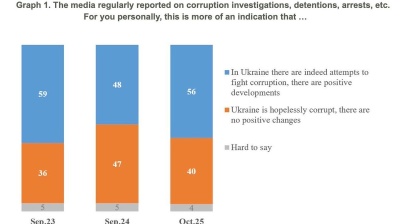Many of Ukraine’s cows have found themselves on the front line and some have been killed or were simply slaughtered when their owners fled the country to escape the invading Russian forces in 2022.
Last year the Ukrainian cattle industry continues to grapple with the chaos that has affected milk, dairy and meat production, but began to stabilise in 2023, according to a recent report by the US Department of Agriculture (USDA) Global Agricultural Information Network (GAIN), and even managed to export over $600mn worth of meat in the first eight months of 2023.
Famous for its vast expanses of golden wheat fields that grow in Ukraine’s “black earth”, some of most fertile land on the planet, Ukraine’s cattle and dairy sector has remained surprisingly underdeveloped. Grain dominates agriculture and earns the government billions of dollars a year in exports. Ukraine is also poultry and eggs powerhouse, as well as being a major pork producer. But the legacy of the Soviet-era where cattle and meat production was underemphasised means today’s half Ukraine’s livestock is owned by private households. And after some 8mn Ukrainians fled the country after the war with Russia began two years ago, that has hurt the sector.
GAIN reports that after a significant drop in animal inventory and beef production in 2022, the industry continued its decline in 2023. However, there was a slight uptick in the share of cows in efficient industrial farms, rising from 38% to 41%, with the decline mainly attributed to households.
The dairy sector, a major force impacting beef production and exports, witnessed increased efficiency in 2023, contributing to the stabilisation of cow inventory. Despite the overall downward trend, domestic consumption of dairy products stabilised, slowing down the decrease in animal inventory. Milkiland, the country’s largest producer of dairy products with subsidiaries in Poland and Russia, has seen its development stymied by the conflict.
As a result Ukraine heavily relies on imports for most dairy products, especially for fancy cheese, with Poland as the largest European supplier of dairy products to Ukraine, commanding a 50% market share. Polish products dominate Ukrainian imports, constituting 79% for milk and sour cream, 79% for yoghourt, 72% for cheese, 51% for curd, 44% for whey powder, and 15% for butter. In contrast, Ukraine supplies mostly dried milk, butter, and whey powder to Poland.
While the situation is expected to stabilise further in 2024, the number of cattle is still projected to decline. Exports of live cattle and beef are anticipated to remain strong, although animal exports are expected to decrease due to a lower inventory.
The impact the war on Ukraine's cattle operations has been significant, with many cow owners forced to slaughter their animals due to fleeing the country or disruptions in the milk sale chain. The vulnerability of the dairy industry to war impacts, stemming from its reliance on stable cash flow from milk sales, led to mass short-term animal slaughter.
Historically, Ukraine has prioritised grain production over large-scale livestock businesses, with minimal investment directed towards beef and dual-purpose cattle. Poultry remains a predominant sector, while meat, particularly pork, has been less popular.
Georgy Kukhaleishvili, an analyst at the Association of Milk Producers, noted a decline in Ukraine's cattle population, with the number of cattle decreasing by 160,300 heads (-6.8%) and cows decreasing by 74,800 heads (-5.7%) as of December 2023.
While the meat production sector faces challenges, meat imports have increased by 10%, reaching 95% of 2021 figures. Despite this, dairy product production and exports have seen growth since mid-autumn, with Ukraine exporting 8,790 tonnes of dairy products worth $18.15mn in October 2023, representing a 20% increase from the previous month.
The USDA report notes that dairy producers have learned to manage some war risks. Efforts to fortify energy generation and power grids have made the industry more resilient to power outages. Additionally, low feed prices, as a result of so much of Ukraine’s grain and corn being trapped in the country due to Russia’s naval blockage, have helped offset some wartime losses and kept production costs low.
However, concerns remain about market access for crop farmers, coupled with higher logistics costs, resulting in lower prices in 2023. Access to export markets has been constrained, although exports through Ukraine's Odesa region ports have resumed following the establishment of an temporary corridor in the Black Sea last October.
Taras Vysotskyi, First Deputy Minister of Agrarian Policy, reported boosted meat exports, citing an 11.9% increase in exports valued at $617.1mn in the first eight months of 2023. Additionally, Ukraine plans to quadruple its pig population by 2025, aiming to lower domestic pork prices and bolster meat exports, shifting focus from grain exports.
Features

BEYOND THE BOSPORUS: Investigators feel collar of former Turkish central bank deputy governor
Regime gangs continue to hustle for gains. Some Erdoganist businessmen among the losers.

Journalist beaten to death in Istanbul as security conditions in Turkey rapidly deteriorate
Publisher, meanwhile, is shot in leg. Reporters regularly experience violence, judicial harassment and media lynching.

Agentic AI becomes South Korea’s next big tech battleground
As countries race to define their roles in the AI era, South Korea's tech giants are now embracing “agentic AI”, a next-generation form of AI that acts autonomously to complete goals, not just respond to commands.

Iran's capital Tehran showcases new "Virgin Mary" Metro station
Tehran's new Maryam metro station honours Virgin Mary with architecture blending Armenian and Iranian design elements in new push by Islamic Republic




